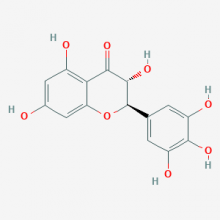Inhibition of dihydromyricetin on several common bacteria in FoodPosted by API-Manufacturer on March 26th, 2019 Plants themselves can synthesize certain secondary metabolites with antibacterial activity and act as a defense against microorganisms. Some flavonoids and isoflavones belong to secondary metabolites of this plant and also have certain antibacterial activity. It has been reported that flavonoids, flavonol flavone ligands and apigenin ligands have certain Antibacterial activities. Dihydromyricetin, known as dihydromyricetin (DMY), is also a flavonoid found in the stems and leaves of Ampelopsis grosseden-tata plants. The DMY monomer of effective fraction is above 27%, which has research and development value. Studies have shown that the leaf extract of the ampelopsis grossedentata has a certain inhibitory effect on bacteria and mold, and the antibacterial activity of DMY has not been reported. Therefore, this experiment aims to study the antibacterial effect of DMY on several common bacteria in food, in order to provide reference for food preservation and DMY development. Food is easily susceptible to suffer microbial contamination and decays. Adding micro-preservatives to foods is a convenient, low-cost, cost-efficient, good-effect method to prevent food from rotting. It plays an irreplaceable role in actual production. At present, commonly used preservatives in production include sorbic acid, benzoic acid, parabens, etc., which have certain toxicity. With the enhancement of people's living standards, it's irresistible that food preservatives with health-care functions need to be developed. Bacteriostatic experiment and dihydromyricetin
Milk rancid mixed bacteria: 1% mixed bacteria were inoculated with different amounts of DMY and benzoic acid broth, and cultured at 37 °C on a shaker. The A60 value was determined by timing sampling, and the inoculation medium without preservative was used as a contrast. conclusionFlavonoids are widely existed in natural foods such as vegetables, fruits, and tea, which can reduce the occurrence of cardiovascular diseases, inhibit the self-swallowing of white blood cells, and antiviral and antibacterial effects. Studies have shown that phenolic substances can destroy the integrity of cell wall and cell membrane, resulting in the release of intracellular components from microbial cells. This will cause dysfunction of membrane electron transport, nutrient absorption, nucleotide synthesis and ATP activity, thereby inhibiting microbial growth. DMY is a flavonoid substance extracted from the ampelopsis grossedentata, but its antibacterial effect is rarely reported. In this paper, the inhibitory effect of DMY on several common bacteria in food was studied. The results showed that DMY had significant inhibitory effects on milk rancid mixed flora and mold. The rancid mixed flora of milk is mainly based on bacteria and has strong adaptability. The mixed bacteria group treated with DMY in this experiment shows that the antibacterial effect is enhanced with the increase of concentration, and the antibacterial effect of DMY is the best with .1%. It can be inferred that DMY has an inhibitory effect on bacteria on the mold. As the concentration of DMY increases, the antibacterial activity increases, and the antibacterial effect is best with 0.1% aqueous solution. The antibacterial effect on yeast is not obvious. It may be due to the thick cell wall of yeast cells. It is difficult for DMY to pass through the cell wall to act on the cell membrane, and yeast is a single-cell microorganism. Therefore, DMY has an inhibitory effect on common bacterial milk rancid bacteria and penicillium citrinum in food preservation. In addition, as a food additive, DMY is safe and easy to obtain, and have certain health-care effects on the human body. Therefore, it can be applied to fruits and vegetables susceptible to mold and anti-corrosion and preservation of dairy products that are easily infected by milk rancidity. Like it? Share it!More by this author |



